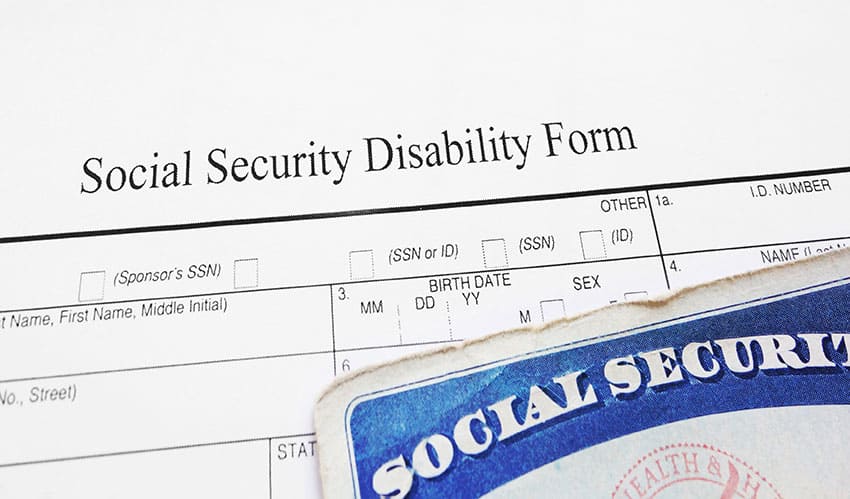Given how rigorous the process is to successfully collect disability payments, it’s fair to wonder, “what conditions automatically qualify you for disability benefits?” After all, you need assistance fast, and the quicker you get it, the better.
Sadly, no single condition or ailment leads to automatic qualification to collect disability benefits. All potential candidates for such assistance must have their circumstances reviewed by the Social Security Administration (SSA) to see if they meet the requirements to qualify for Social Security disability.
There is some clarity on this issue, as the SSA provides a “Blue Book” that lists reviewable conditions if you’re applying for disability benefits, such as:
- Chronic bronchitis, asthma, emphysema, and other respiratory disorders
- Skeletal spine injuries, joint injuries, and other musculoskeletal disorders
- Blindness, visual disorders, and other special sense/speech issues
- Liver dysfunction, inflammatory bowel disease, and other digestive system disorders
- Chronic heart failure and other cardiovascular disorders
- Illnesses revolving around the genital or urinary organs and other genitourinary disorders
- Blood/blood/forming organ-based illnesses (i.e., hematological disorders)
- Chronic skin infections, dermatitis, and other skin disorders
- Pituitary gland illnesses, thyroid gland illnesses, and related endocrine disorders
- Anxiety, depression, bipolar disorder, and other mental illnesses
- Benign brain tumors, epilepsy, and other neurological disorders
- Congenital issues impacting various systems in the body
- Malignant neoplastic diseases and other forms of cancer
- Inflammatory arthritis, lupus, HIV infection, and other immune system disorders
These conditions can all be found in the SSA’s Listing of Impairments – Adult Listings (Part A). These requirements to qualify for Social Security disability apply to all people who are 18 plus years of age. Some disabilities may not be on the list for instance is ADHD a Disability? There are numerous questions we can answer whether or not this will hinder you from getting the disability benefits you deserve.
Conditions in these categories are classified by the SSA as severe due to the limitations they cause in a person’s daily functioning.
Are you or a family member dealing with a disability preventing you from earning income and living your day-to-day life? Then you might meet the requirements to collect Social Security Disability (SSD) benefits.
Do you intend to apply for SSD benefits? Streamline the process by having BenefitsClaim.com evaluate your case for free to see if you’ll qualify!
Is Your Impairment On The SSA’s List? If Not, Don’t Worry-It Doesn’t Need To Be
So, you now know the answer to “what conditions automatically qualify you for disability?” It’s none of them.
The Blue Book lets you know what conditions give you the best chance to collect disability income from the SSA–but it doesn’t tell the whole story.

Namely, the SSA doesn’t need your impairment to be on its list to approve your application. Carpal tunnel syndrome and celiac disease are examples of conditions that aren’t listed but are viable in the SSA’s eyes.
When trying to collect disability with an unlisted condition in the requirements to qualify for Social Security disability, you must provide a formal diagnosis to the SSA proving that the problem is a “medically determinable impairment.” Moreover, this diagnosis must show that you can’t function at your full capacity.
In other words, the condition must stop you from performing daily activities and working–a reduction referred to as “residual functional capacity.”
Your condition might be considered by the SSA as equivalent to one of its listed impairments if it ticks the necessary boxes. Note that receiving your doctor’s diagnosis of your disability is only the beginning of your SSD journey–you won’t be automatically approved.
Whether Listed Or Unlisted, Your Condition Must Be Severe Enough To Collect SSD Payments
Listed and unlisted impairments have one specific thing in common in the eyes of the SSA. Their medical documentation alone isn’t enough to qualify for SSD payments.
Is your condition listed? If so, your medical records and diagnosis must adhere to SSA’s requirements for the given impairment. Any medical proof you give to the SSA must match your signs, symptoms, and other impairment criteria.
You can present medical evidence if your condition doesn’t meet the listed condition requirements, and the SSA can review it. From there, they’ll decide if your impairment is severe enough to meet the standards to receive benefits.
Further Medical Conditions That Might Entitle You To SSD Payments
While there are conditions listed by the SSA in their Blue Book, each applicant for disability benefits has unique circumstances that could lead to receiving payments.
Thus, it’s essential to know some more specific SSA-listed medical issues that fall under its broader categories, such as:
- Connective tissue disorders
- Cerebral Palsy
- Inflammatory bowel disease
- Liver disease
- Epilepsy
- Traumatic brain injury
- Inflammatory arthritis
- Multiple sclerosis
- Bipolar disorder
- Depressive disorder
The above conditions are only a fraction of the SSA’s many listed impairments required to qualify for disability benefits through one or several federal programs.
You might also need to provide more context to help the SSA determine eligibility and how many benefits you’ll receive if eligible with the requirements to qualify for Social Security disability.
Again though, if you want to know what conditions automatically qualify you for disability, the answer is none.
Successfully Applying For Disability Benefits Isn’t Easy
Initial applications to collect disability benefits are frequently denied by the SSA for any number of reasons, such as:
- Medical information that’s led to a disqualification
- Technical issues with the application
Additionally, while not likely, SSDI or SSI application errors can happen.
For further context, there’s only a 22% acceptance rate for initial applications and a 63% denial rate for SSDI applications. Applying for disability benefits is not exactly an a-to-b process for the majority of applicants.
Fortunately, you don’t need to go through this process alone–you can work with a third party as your guide.

Compassionate Allowances: A Fast-Track Program for Severe Disabilities
The Social Security Administration has a special program with requirements to qualify for social security disability called Compassionate Allowances (CAL) that allows for expedited processing of disability claims for applicants with certain severe medical conditions. These conditions are so serious that they clearly meet the SSA’s definition of disability. Examples include acute leukemia, Lou Gehrig’s disease (ALS), and pancreatic cancer. If your condition is on the CAL list, your application may be approved in a matter of weeks rather than months. However, even with a CAL condition, you still need to provide sufficient medical evidence to support your claim.
Navigating the Disability Appeals Process: What to Do If Your Claim Is Denied
If your initial application for disability benefits is denied, don’t lose hope. You have the right to appeal the decision through a multi-stage process. The first stage is reconsideration, where a new SSA reviewer will look at your case. If you’re denied again, you can request a hearing before an Administrative Law Judge (ALJ). If the ALJ denies your claim, you can appeal to the Appeals Council. The final stage is filing a lawsuit in federal court. Having an experienced disability attorney guide you through the appeals process can significantly increase your chances of a successful outcome.
How Often Will the SSA Review Your Case?
Even if you have the requirements to qualify for social security disability and start receiving disability benefits, the SSA will periodically review your case to ensure you still meet the eligibility criteria. These reviews are called Continuing Disability Reviews (CDRs). The frequency of CDRs depends on the severity of your condition and the likelihood of improvement. If your condition is expected to improve, your first CDR may be 6-18 months after you start receiving benefits. If improvement is possible but can’t be predicted, the CDR will likely be every 3 years. If improvement is not expected, the CDR will generally be every 7 years. It’s important to continue medical treatment and promptly respond to any SSA requests for information to maintain your benefits.
Exploring Work Incentives: Returning to Work While on Disability Benefits
The SSA offers several work incentive programs to encourage disability beneficiaries to return to work if and when they are able. These programs allow you to test your ability to work without immediately losing your benefits or Medicare/Medicaid coverage. For example, the Trial Work Period allows SSDI recipients to work for at least 9 months (not necessarily consecutive) and still receive full benefits regardless of how much they earn. The Ticket to Work program provides free employment services to help beneficiaries transition back into the workforce. Understanding these work incentives can help you make informed decisions about employment while on disability.
SSI for Children with Severe Conditions
Children under 18 can also qualify for disability benefits through the Supplemental Security Income (SSI) program if they have a severe medical condition that meets the SSA’s definition of disability for children. The child’s condition must cause “marked and severe functional limitations” and be expected to last for at least 12 months or result in death. Some conditions that may qualify include Down syndrome, cerebral palsy, intellectual disability, and autism. In addition to the child’s medical condition, the SSA will also consider the family’s income and resources when determining eligibility for SSI.
Work With An Expert To Guide You Through The Process
At BenefitsClaim.com, we leave no stone unturned in supporting Americans in filing and receiving financial assistance from the government–this includes disability benefits throughout all 50 states.
We’re here to help you get the benefits you deserve and figure out what medical conditions qualify for social security disability. Get a case evaluation for free. Just click here and fill out our 1-minute form to see how much you could receive!


